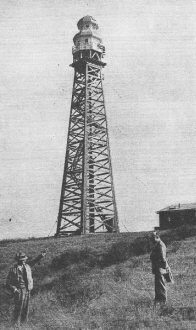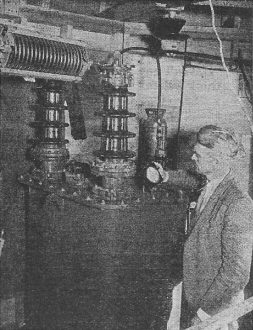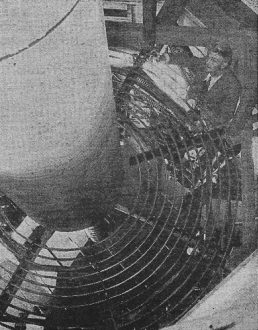|
1934 was still riding the back
of the high voltage craze popularized by Nikola Tesla at the turn of the
century. Super high voltage spark gap transmitters were still being used in long
distance communications for special applications. William Haight was one of many
people engaged in weather manipulation - both its creation and destruction.
Transportation, agriculture, and recreation would greatly benefit from the
ability to locally and temporarily control weather. This story of Mr. Haight's
high-voltage "electrodrome" machine appeared in the May 1934 issue of Flying
Aces magazine. Another
version of this electrodrome article by author Mel Wharton, entitled "Eliminating
the Peril of Fog," appeared in the April 1934 edition of Flying magazine.
There he says, "Repeated tests have shown that the operations of dispersing fog
is most effective at about 600,000 cycles [600 kHz] - though work is done all
the way on a range from 500,000 to 1,500,000 cycles. The machine is capable of
developing 500,000 volts, but only a fraction of this voltage is found
necessary." A 4½ horsepower gasoline engine-powered generator provides the
voltage. A May 1935 issue of Popular Mechanics magazine reports on Mr. Haight's
electrodrome work that "...an attempt to dissipate the fog of San Francisco
Harbor by discharging high voltage bolts of electricity was unsuccessful..." It
also mentions that Marconi did some experiments to crate a "radio lighthouse"
that could burn a hole through fog in harbors to guide ships to port. History
has pretty much proven the electrodrome to be a failure, which is too bad since
it would have been a great tool for combating low visibility.
Electrodrome: Fog and Poison Gas

What the electrodrome looks like. Here's the 130-foot structure near Whittier,
California, invented by William Haight, scientist and engineer. From this electrodrome,
experiments have been conducted by which fog was successfully dispersed over a radius
of 1 1/2 miles. What's more, this apparatus can bore a three-mile-in-diameter hole
through fog straight up toward the stars.
Will This Invention Spell Their Doom?
By Mel Wharton
Will airplanes no longer have to face destruction, their pilots combat death,
in the danger-filled fogs that fill the air? Will people no longer have to fear
the horror of poisonous gases choking their lives out in time of war? There is an
answer to these questions in the story we give you here - the story of an amazing
new invention that may revolutionize air hazards - and spell the doom of fog and
poison gas. It's called the electrodrome - and we wouldn't blame the U. S. government
for casting an interested eye in its direction!
Fog, transportation's most tenacious enemy, is asking for armistice. Poison gas,
that great hazard of war time, is pleading for mercy.
A towering dome that spurts electrostatic waves into the surrounding atmosphere
successfully dissipates fogs for a radius of one and one-half miles. And in from
two to 22 minutes from the time the apparatus is working a three-mile diameter "hole"
is bored through the fog straight up to the stars. This experimental "electrodrome"
is located near Whittier, California, thirty miles due east of Los Angeles.
The method is the brain child of William Haight, California scientist and engineer.
In effect, the electrical waves condense the fog, quickly precipitating it. The
affected area is kept clear as long as the machine keeps in operation.
Ever since man learned to harness power for locomotion, fog has been his greatest
menace. Property destruction due to fog, measured in dollars and cents, has been
estimated to amount since the Christian era to a sum vaster than America's whole
debt. Underwriters will tell you insurance rates are considerably influenced by
the constant peril of fog.
It is without contradiction that air transportation has suffered more proportionately
from fog than has any other means of travel. Every air transportation expert knows
that until fog is conquered, a serious impediment is blocking the progress of air
flight. Inventor Haight claims that a single electrodrome placed at every airport
and at intervals along established air routes will solve this problem.
But what about cost?
A plant consists of a derrick-type tower, 130 feet high, transformers, condensers,
a modified Tesla, coil, spark gap for regulating frequency, and a dispersion electrode
atop the dome, by means of which the electrostatic energy reaches the atmosphere.
More than enough power to operate is obtained from the moderate-sized motor of a
well-known make of American automobile. The cost will not be prohibitive to any
well-equipped airport, the inventor claims.
Oddly enough, Mr. Haight was seeking to produce fog when he discovered the unique
fog-dispersing ability of his apparatus. It was an attempt to produce artificially
a protecting fog blanket for California's orange, lemon and grapefruit belts that
led to the development of what now seems likely, according to informed persons,
to add a new safety chapter to transportation.
In the creation of fog, the inventor was only moderately successful, being able
to induce high clouds above the electrodrome in from thirty minutes to two hours.
Positive electrostatic waves were employed.
According to the Haight theory, electrical circulations flow at high altitudes
around the earth between the magnetic poles. These currents rise and dip with the
contour of the earth's surface, and for other reasons, not all of which are as yet
an open book to science. This flow of electricity between the earth and upper atmospheric
strata is supposed to become condensed into what we commonly know as fogs, clouds
and rain, as well as other and sometimes more violent manifestations.

Inventor William Haight, standing beside one of the transformers which constitute
part of the fog-dispelling equipment. Every one of those little knobs and coils
helps to cut a hole through fog.

Looking down one of the Tesla-type coils located on top of the electrodrome's
mast. The maximum capacity of the coil is about 500,000 volts. Quite a current!
This theory was demonstrated in the science laboratories at Occidental College,
Los Angeles, before being reproduced out of doors. Apparatus used consisted of an
air-tight box into which any degree of atomized moisture could be sprayed at will.
A bottom metal plate in the box was connected with the negative terminal of a static
machine, and simulated the earth. Suspended outside the box was a metal ball, positively
charged. By maneuvering the distance between charged ball and plate, the moisture
inside the box could be completely precipitated. The electrodrome was then designed
to create like effects in the open.
Mr. Haight believes the vertical rise of energy between negative earth and the
positive upper air strata creates the low-pressure areas of condensation. An interesting
commentary is that barometric readings show drops of from three to ten points, it
is said, in the field created by the electrodrome in operation.
That the creation of fog-free ports will be made feasible, by the placing and
overlapping of the effective radiation areas of the electrodromes, is the opinion
of the inventor.
"A discouraging economic waste results yearly to shipping through the difficulty
of entering fog-bound ports, to say nothing of collision destruction and vital losses,"
asserts Mr. Haight. "Millions could be saved annually if visibility can be created
in and about the world's chief ports.
"Already I am anticipating the time when every sizable ship will be equipped
with a compact electrodrome to cut a clear slice through the fog by concentrating
the electrostatic waves with some directing device, perhaps somewhat like that used
now in short-wave radio communication. With such equipment, collision on the high
seas would indeed become a rare accident.
"The electrodrome principle also has its military function in facilitating protection
from air raids. Cities like London and Paris could be kept fog-free at all critical
times. The terrors incident to bombing would likewise vastly disappear.
"Inasmuch as every poisonous gas contains moisture, I foresee a virtual stalemate
to this form of attack by the concentration of cleverly camouflaged, or even collapsible,
electrodromes kept underground, and brought instantly into action when needed,"
continued the California scientist. "Poison gas could be easily dissipated before
reaching its objective."
Air swirls manufactured in wind tunnels - swirls similar to our American cyclones
- have been reduced to nothing more than gentle zephyrs by the application of the
electrostatic field, the inventor has demonstrated.
"By placing specially constructed apparatus at strategic points in well-established
cyclone areas - say, at intervals of every ten miles - I am firmly convinced that
the teeth of such atmospheric disturbances could be pulled and their destructiveness
limited to what would normally accompany any moderately strong wind storm," concludes
Mr. Haight. "Science has long been working towards this end, and I believe electrostatic
waves hold the answer to this vexatious problem that has so repeatedly wrought havoc
and death over large portions of our country."
Military observers should be interested in the gas-dissipating and fog-penetrating
features of this electrostatic machine. Smaller models, somewhat like the portable
searchlights of airports, could be built for armies in the field. With them, early-morning
fog could be dispelled, and the old Western Front hazard of early attacks prevented.
The gas-dissipating feature could be used in the first stages of gas attacks, particularly
those using gasses propelled by favorable winds. The poison gas could either be
completely dissipated and made harmless, or the prevailing winds, carrying it, could
be broken up or redirected, so that the enemy vapor could be sent back at them.
Uncle Sam should be interested in this remarkable invention. It appears to have
an important place, either in peace or war.
Posted June 13, 2022
|